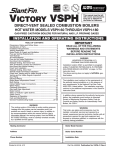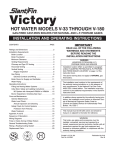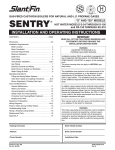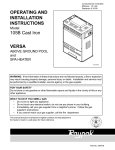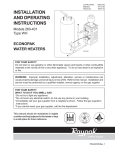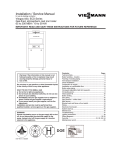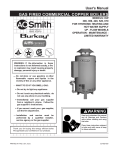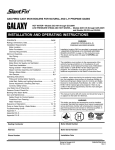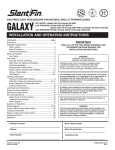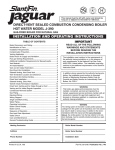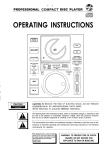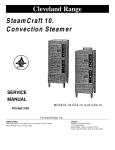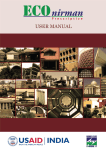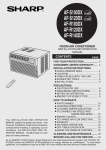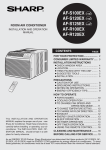Download Slant/Fin VHS-30 User's Manual
Transcript
® VICTORY II ™ This manual must be left with owner and should be hung on or adjacent to the boiler for reference. HOT WATER MODELS VHS-30 THROUGH VHS-180 GAS-FIRED CAST-IRON BOILERS FOR NATURAL AND L.P. PROPANE GASES Models with Intermittent Pilot System – Spark Ignition INSTALLATION AND OPERATING INSTRUCTIONS Contents . . . . . . . . . . . . . . . . . . . . . . . . . . . . . . . . . . . . . .Page Dimensions, Rating and Orifice Sizes . . . . . . . . . . . . . . . . . . .2 Installation Requirements: Boiler Location and Foundation . . . . . . . . . . . . . . . . . . . . .3 Minimum Clearances . . . . . . . . . . . . . . . . . . . . . . . . . . . . .3 Boiler Room Air Supply and Ventilation . . . . . . . . . . . . . . .4 Flue Gas Venting Requirements . . . . . . . . . . . . . . . . . . . . . . .4 Category II and III Venting: Venting Material . . . . . . . . . . . . . . . . . . . . . . . . . . . . . . . . .5 Flue Length Restriction . . . . . . . . . . . . . . . . . . . . . . . . . . .5 Installation . . . . . . . . . . . . . . . . . . . . . . . . . . . . . . . . . . . . .5 Category I Venting: Installation . . . . . . . . . . . . . . . . . . . . . . . . . . . . . . . . . . . .10 Vent Connector Material . . . . . . . . . . . . . . . . . . . . . . . . . .10 Venting Requirements . . . . . . . . . . . . . . . . . . . . . . . . . . .10 Venting System Regular Inspection . . . . . . . . . . . . . . . . . . . .14 Gas Piping . . . . . . . . . . . . . . . . . . . . . . . . . . . . . . . . . . . . . . .14 Electrical Wiring . . . . . . . . . . . . . . . . . . . . . . . . . . . . . . . . . . .14 Water Piping . . . . . . . . . . . . . . . . . . . . . . . . . . . . . . . . . . . . . .15 Piping a Heating-Cooling System . . . . . . . . . . . . . . . . . . . . .18 Operating Instructions: Filling and Venting Water Systems . . . . . . . . . . . . . . . . . .18 Initial Start . . . . . . . . . . . . . . . . . . . . . . . . . . . . . . . . . . . .18 Safety Information . . . . . . . . . . . . . . . . . . . . . . . . . . . . . .19 Operating Instruction . . . . . . . . . . . . . . . . . . . . . . . . . . . .19 Burner Adjustment . . . . . . . . . . . . . . . . . . . . . . . . . . . . . .19 Safety Check . . . . . . . . . . . . . . . . . . . . . . . . . . . . . . . . . . . . .20 Care and Maintenance . . . . . . . . . . . . . . . . . . . . . . . . . . . . . .21 Sequence of Operations . . . . . . . . . . . . . . . . . . . . . . . . . . . .23 General Troubleshooting Guide . . . . . . . . . . . . . . . . . . . . . . .24 Appendix A and B . . . . . . . . . . . . . . . . . . . . . . . . . . . . . . . . .26 WARNING The venting system of this boiler is under positive pressure when it is connected to the outdoors with 3" diameter pipe. Leakage from this system can be hazardous and if not avoided can result in death or serious injury. In addition to the recommendations within this manual and the User’s Information Manual, the venting system, from the blower to the outdoor discharge, must be carefully checked annually by a qualified service agency. IMPORTANT READ ALL OF THE FOLLOWING WARNINGS AND STATEMENTS BEFORE READING THE INSTALLATION INSTRUCTIONS WARNING LIQUEFIED PETROLEUM (L.P.) PROPANE GAS-FIRED BOILERS Installation location ONLY as permitted in paragraph entitled "LIQUEFIED PETROLEUM (L.P.) PROPANE GAS-FIRED BOILER LOCATION" on page 3 of this instruction book. The above warning does not apply to NATURAL gasfired boilers. The installation must conform to the requirements of the authority having jurisdiction or, in the absence of such requirements, to the National Fuel Gas Code, ANSI Z223.1-latest edition. The installation must also conform to the additional requirements in this Slant/Fin Instruction Book. In addition where required by the authority having jurisdiction, the installation must conform to American Society of Mechanical Engineers Safety Code for Controls and Safety Devices for Automatically Fired Boilers, No. CSD-1. WARNING This boiler, gas piping and accessories must be installed, connected, serviced and repaired by a trained, experienced service technician, familiar with all precautions required for gas-fired equipment and licensed or otherwise qualified, in compliance with the authority having jurisdiction. Heating Contractor Boiler Model Number Address Boiler Serial Number Phone Number Installation Date Publication No. VHS-40 Part No. 44-0831 Printed in U.S.A.404 VICTORY II VHS Models Figure 1. Views - Dimensions - Data LEFT END VIEW FRONT VIEW RIGHT END VIEW NOTE: Height dimensions increase by 13⁄4" and depth increases to 221⁄4" when combustible floor kit is used. Boiler Model Input Btuh No. of Sections A B 1 Approx. Total Wt. Full of Water (lb.) VHS-30 30,000 2 8 ⁄8" 145⁄8" 190 VHS-60 60,000 3 11 ⁄8" 175⁄8" 250 VHS-90 90,000 4 141⁄8" 205⁄8" 310 VHS-120 120,000 5 17 ⁄8" 23 ⁄8" 365 VHS-150 150,000 6 20 ⁄8" 26 ⁄8" 425 VHS-180 180,000 7 231⁄8" 295⁄8" 485 1 1 5 1 5 Figure 2. Base Assembly Victory II - VHS Boiler Burners Pilot Burner access door Gas valve Gas manifold Gas Type Orifice Size for Sea Level Orifice Sizes for High Altitudes Includes 4% Reduction for Each 1000 Feet 2000 3000 4000 Elevation — Feet 5000 6000 7000 8000 9000 10000 Natural #49 50 50 50 51 51 51 52 52 52 Propane #57 58 59 59 60 60 61 62 63 63 Orifice sizes indicated for sea level above are factory installed in boiler unless otherwise specified by the local authority. Orifice table is based on a higher heating value between 1000 Btuh and 1010 Btuh for Natural Gas (See page 19, if local higher heating value exceeds these numbers). See page 19, for burner input adjustment. 2 VICTORY II VHS Models INSTALLATION REQUIREMENTS The installation must conform to the requirements of the authority having jurisdiction or, in the absence of such requirements, to the National Fuel Gas Code, ANSI Z223.1latest edition. This installation must also conform to the additional requirements in this Slant/Fin Instruction Book. NATURAL GAS-FIRED BOILER LOCATION Provide a level, solid foundation for the boiler. Location should be as near as possible to chimney or outside wall so that the flue pipe from boiler is short and direct. (See Appendix A for vent terminal location restrictions.) The location should also be such that the gas ignition system components are protected from water (dripping, spraying, rain, etc.) during appliance operation and service (circulator replacement, condensate trap, control replacement, etc.). WARNING LIQUEFIED PETROLEUM (L.P.) PROPANE GAS-FIRED BOILER LOCATION REQUIRES SPECIAL ATTENTION Liquefied Petroleum (L.P.) propane gas is heavier than air. Therefore, propane boilers, piping, valves should NOT be installed in locations where propane leaking from defective equipment and piping will "pool" in a basement or other space below the leak. MINIMUM CLEARANCES FROM COMBUSTIBLE CONSTRUCTIONS A. Minimum clearances to the exterior surfaces of the boiler shall be as follows: MINIMUM ALCOVE AND CLOSET CLEARANCE For Combustible Surface Construction Front 6" Rear 6" Left Side 6" Right Side 12" Top 12" Flue Connector: Enclosed — 6" Unenclosed — 2" Recommended for Service 18" 18" 18" 24" 12" 6" 6" B. Provide accessibility clearance of 24" on sides requiring servicing and 18" on sides used for passage. C. All minimum clearances shown above must be met. This may result in increased values of some minimum clearances in order to maintain the minimum clearances of others. D. Clearance from hot water pipes shall be 1 inch**. ** At points where hot water pipes emerge from a floor, wall or ceiling, the clearance at the opening through the finished floor boards or wall or ceiling boards may be not less than 1/2 inch. Each such opening shall be covered with a plate of uncombustible material. A spark or flame from the boiler or other source may ignite the accumulated propane gas causing an explosion or fire. Provide a level, solid foundation for the boiler. Location should be as near the chimney as possible so that the flue pipe from boiler to chimney is short and direct. The UNIFORM MECHANICAL CODE may be in effect in your geographic area. The following precautions are cited by the 1994 UNIFORM MECHANICAL CODE, section 304.6: "LPG Appliances. Liquefied petroleum gas-burning appliances shall not be installed in a pit, basement or similar location where heavier-than-air-gas might collect. Appliances so fueled shall not be installed in an abovegrade under-floor space or basement unless such location is provided with an approved means for removal of unburned gas." Consult Chapter 5 of the 1994 UNIFORM MECHANICAL CODE for design criteria of the "approved" means for removal of unburned gas. BOILER FOUNDATION A. Provide a solid, level foundation, capable of supporting the weight of the boiler filled with water, and extending at least 2" past the jacket on all sides. See dimensions of boilers, page 2. B. For installation on non-combustible floors only*. C. If boiler is to be located over buried conduit containing electric wires or telephone cables, consult local codes or the National Board of Fire Underwriters for specific requirements. * Installation on combustible flooring allowed only with proper Combustible Floor Kit. Kit part number is printed on boiler rating plate. In no case may the boiler be installed on carpeting. Figure 3. SAFETY KEEP THE BOILER AREA CLEAR AND FREE FROM COMBUSTIBLE MATERIALS, GASOLINE AND OTHER FLAMMABLE VAPORS AND LIQUIDS. 3 VICTORY II BOILER ROOM AIR SUPPLY AND VENTILATION An ample supply of air is required for combustion and ventilation. When buildings are insulated, caulked and weatherstripped, now or later on, direct openings to outside may be required and should be provided. If the boiler is not near an outside wall, air may be ducted to it from outside wall openings. Provisions for combustion and ventilation air must be made in accordance with section 5.3, Air for Combustion and Ventilation, of the National Fuel Gas Code, ANSI Z223.1-latest edition, or applicable provisions of the local building codes. The following recommendation applies to buildings of energy-saving construction, fully caulked and weatherstripped. INSTALLATION IN ENCLOSED BOILER ROOM REQUIRES TWO UNOBSTRUCTED OPENINGS FOR PASSAGE OF AIR INTO THE BOILER ROOM: 1. Air drawn horizontally from outdoors DIRECTLY through an outside wall; one louvered opening near the floor and one louvered opening near the ceiling, each opening with a minimum FREE air passage area of 1 square inch per 4000 Btuh of total appliances’ input. 2. Air drawn horizontally through HORIZONTAL DUCTS; one opening near the floor and one opening near the ceiling, each opening with a minimum FREE air passage area of 1 square inch per 2000 Btuh of total appliances’ input. 3. Air drawn VERTICALLY from outdoors; one opening at the floor and one opening at the ceiling, each opening with a minimum FREE air passage area of 1 square inch per 4000 Btuh of total appliances’ input. 4. Air drawn from inside the building; one opening near the floor and one opening near the ceiling, each opening with a minimum FREE air passage area of 1 square inch per 1000 Btuh of total appliances’ input. IF BOILERS ARE INSTALLED ADJACENT TO OTHER FUEL BURNING EQUIPMENT, THE AREA OF FREE OPENINGS MUST BE APPROPRIATELY INCREASED TO ACCOMMODATE THE ADDITIONAL LOAD. Openings must never be reduced or closed. If doors or windows are used for air supply, they must be locked open. Protect against closure of openings by snow and debris. Inspect frequently. No mechanical draft exhaust or supply fans are to be used in or near the boiler area. The flow of combustion and ventilating air to the boiler must not be obstructed. 4 VHS Models FLUE GAS VENTING REQUIREMENTS The Victory II series boiler is a high efficiency, mechanically induced draft boiler and, therefore, requires different venting arrangements than natural draft, lower efficiency boilers. THE FOLLOWING INSTRUCTIONS MUST BE CAREFULLY READ AND FOLLOWED IN ORDER TO AVOID ANY HAZARDOUS CONDITIONS DUE TO IMPROPER INSTALLATION OF THE FLUE GAS VENTING SYSTEM. The vent piping installation MUST be in accordance with these instructions and with ANSI Z223.1-latest edition NATIONAL FUEL GAS CODE, Part 7, Venting of Equipment. Other local codes may also apply and must be followed. Where there is a conflict between these requirements, the more stringent case shall apply. The use of a vent damper is NOT permitted on this boiler series. Approved Venting Applications Victory II model VHS-90 through 180 are Category III and VHS-30 and 60 are Category II boilers, these boilers must be vented by proper 3" diameter venting system (see Category II and III venting - page 5). Models VHS-90 through 180 are also Category I boilers when using a minimum of 5" diameter connector and vented into a natural draft chimney or Type “B” vent using a 3"x5" diameter vent adapter (see Category I venting - page 10). VICTORY II VHS Models 2. Flue Length Restriction Maximum and minimum equivalent flue length for different systems are given in the tables on page 6. Equivalent flue length is sum of straight flue lengths and equivalent length of elbows. The vent termination is in addition to the allowed equivalent lengths. Example: Boiler Model VHS-180 is to be installed at sea level with 2 elbows using Heat-Fab vent system. Maximum straight run would be: 40 - 2 x 3 = 34ft. If same boiler is to be installed in Colorado Springs (5,980 ft. altitude), the maximum straight run would be: 20 - 2 x 3 = 14 ft. 3. Installation A. Horizontal Venting: Figures 5 and 6 show typical horizontal venting. For combustible wall passage of vent piping a U.L. listed thimble must be used. See Figures 5 and 6 for wall thimble Part Numbers and more information. Figure 4. Vent Sealing Instructions (Consult vent manufacturer’s instructions.) CATEGORY II AND III VENTING 1. Vent Material A) The vent system for horizontal or vertical venting (Category II and III) must be UL listed single wall 3" diameter AL29-4Cs stainless steel material. The following manufacturers’ systems are approved for use within a specified minimum and maximum equivalent vent length for each model. Proper adapter must be used as a connector between Victory II boilers flue collar and venting system as shown below: Manufacturer Type/System Adapter Part No. Sealant Heat-Fab. Inc. Saf-T Vent Not Required RTV 106 or Dow Corning 732 Heat-Fab. Inc. Saf-T Vent EZ Seal Not Required Not Required ProTech System, Inc. FasNSeal FSA-SLB-3 Not Required Flex-L International, Inc. StaR-34 SRASFA3 GE-1S806 Z-Flex, Inc. Z-Vent O2SVSSLA2 GE, RTV 106 Heat-Fab Part Numbers for various items of vent system are listed in Slant/Fin Part List, Publication No. VHS-10PL. B) When joining the various components of the above listed vent systems, the manufacturers’ instructions should be closely followed to insure proper sealing. C) Use sealant specified by vent system manufacturer for sealing of pipe and fittings. See Figure 4 for proper application of vent pipe sealing for Safe-T vent system by Heat-Fab. Inc. D) All vent connections must be liquid and pressure tight E) Flue vent system CANNOT be cut to length. Consult manufacturer’s instructions. For Heat-Fab system, use slip joint connector to adjust pipe lengths dimensions. F) DO NOT use plastic or galvanized flue pipe. B. Vertical Venting: Figure 7 shows typical vertical venting. A fire stop is required for each ceiling and floor penetration. An existing chimney (see Figure 8) may be used as a chase for vertical venting. Other appliances CANNOT be vented into the same chimney or vent pipe within the chimney. For both, horizontal and vertical venting, the following points MUST be followed: A. All Victory II boilers are equipped with a built-in condensation drain and trap. The trap loop must be filled with water. DO NOT operate the boiler without filling the trap with water to prevent flue gas discharge into space. The drain should extend to a floor drain or to a container which may require emptying periodically. B. The horizontal vent pipe must be sloped upward from the boiler at a pitch of at least 1/4" per 1 foot of run, so that the condensate from the vent system runs to the drain trap. C. The horizontal vent pipes must be supported with pipe straps at intervals no greater than indicated by vent pipe manufacturer’s instructions. The vertical portion vent pipe also must be supported per manufacturer’s instructions. D. Minimum clearances of vent pipes from combustible constructions must be maintained (see Page 3). E. Common venting with other appliances or another Victory II boiler is NOT allowed. F. The vent piping must terminate with a screened elbow or tee. See Figures 5 and 6 for horizontal and 7 and 8 for vertical termination information. A cap termination may be used for vertical venting. G. See Appendix A for vent system location and condensation drain requirements. H. For roof passage of vent piping a U.L. listed roof flashing must be used. s: AL 29-4C is a registered trademark of Allegheny Ludlum Corp. 5 VICTORY II Heat-Fab Saf-T Vent System Max. Equivalent Length (Ft.) Boiler Model No. 0 to 5500 Ft. Altitudes Equivalent 5500 to 7000 to Length of 7000 Ft. 10,000 Ft. each 90° Altitudes Altitudes Elbow, Ft. Minimum Length, Ft. VHS-30, 60, 90 and 120 40 40 40 3 2 VHS-150 40 40 20 3 2 VHS-180 40 20 20 3 2 ProTech FasNSeal System Max. Equivalent Length (Ft.) Boiler Model No. 0 to 5500 Ft. Altitudes Equivalent Length of 5500 to 7000 to 7000 Ft. 10,000 Ft. each 90° Elbow, Ft. Altitudes Altitudes Minimum Length, Ft. VHS-30, 60, 90 and 120 30 30 30 6 2 VHS-150 30 30 15 6 2 VHS-180 30 15 15 6 2 Flex-L StaR-34 and Z-Flex Z-Vent System Max. Equivalent Length (Ft.) Boiler Model No. 0 to 5500 Ft. Altitudes Equivalent 5500 to 7000 to Length of 7000 Ft. 10,000 Ft. each 90° Altitudes Altitudes Elbow, Ft. Minimum Length, Ft. VHS-30, 60, 90 and 120 35 35 35 6 2 VHS-150 35 35 18 6 2 VHS-180 35 18 18 6 2 Note: Vent termination is in addition to the allowed equivalent length. 6 VHS Models VICTORY II VHS Models VICTORY II HORIZONTAL (SIDEWALL) VENTING All joints must be liquid and pressure tight. Use U/L listed single wall 3" dia. AL29-4C* S.S. venting materials Figure 5 * Definition of Snow Line: Knowledge of local conditions will reveal the maximum height that repeated snowfalls accumulate to. The height should be used as the SNOW LINE. Figure 6 * Definition of Snow Line: Knowledge of local conditions will reveal the maximum height that repeated snowfalls accumulate to. The height should be used as the SNOW LINE. * : AL 29-4C IS A REGISTERED TRADEMARK OF ALLEGHENY LADLUM CORP. 44vh40-6 REV.A 7 VICTORY II Figure 7. 8 VHS Models VICTORY II VHS Models Figure 8. 9 VICTORY II CATEGORY I VENTING (Natural Draft Chimney and Type “B” Venting) 1. Installation Model VHS-90, VHS-120, VHS-150 and VHS-180 may be vented into a natural draft masonry chimney or natural draft type“B” vent if a 3" diameter stainless steel elbow connected to the boiler’s flue collar and the vent connector converted to 5" diameter using a 3" x 5" vent adapter. Single or multiple appliance venting are shown in Figures 9 and 10. 2. Vent Connector Material Vent connectors may be single wall or Type “B” made of galvanized or stainless steel materials. 3. Venting Requirements If the boiler vent is to be installed into a natural draft masonry chimney or Type “B” venting, it must be in accordance with National Fuel Gas Code ANSI Z223.1-latest edition, Part 7, Part 11 and Appendix G. For a masonry vitreous tile-lined chimney which is not exposed to the outdoors, use Table 1 in this Slant/Fin manual for venting requirements. DO NOT install this system into an unlined masonry chimney. If a masonry chimney is exposed to the outdoors on one or more sides below the roof line (exposed chimney), it must be re-lined with a UL listed metallic liner system. See Table 2 in this Slant/Fin manual for venting requirements of metallic re-lined chimneys. If a Type “B” vent system is used, it must NOT be exposed to the outdoors below the roof line. See Table 2 in this Slant/Fin manual for venting requirements. Vent connectors serving appliances vented by natural draft shall NOT be connected into any portion of mechanical draft systems operating under positive pressure. In some cases, the vent connector diameter must be upsized further to 6" or 7". Refer to Table 1 and 2 for installations requiring this increased size. If this boiler is replacing a boiler which is connected to a common venting system with other natural draft, gas-fired appliances, the removal of the existing boiler from the venting system is likely to cause the system to be too large for proper venting of the appliances remaining connected to it. At the time of removal of the existing boiler, the test procedure specified in Appendix “B” must be followed. 10 VHS Models VICTORY II VHS Models Natural Draft Chimney and Type “B” Venting Tables Table 1. Masonry Vitreous Tile-Lined Chimney (not metal lined) Chimneys not exposed to the outdoors below the roof line. (5" dia. vent adapter must be used) Boiler Model(s) † VHS-90 VHS-120 VHS-150 VHS-180 VHS-180 Additional Gas Appliance in Venting System No No VHS-90 VHS-120 VHS-150 VHS-180 Yes VHS-150 VHS-180 Yes Connector Type “B” Single-wall Type “B” Single-wall 1. 2. 3. 4. 1. 2. 3. 4. Requirements* Connector diameter must be upsized to 7". Chimney height limits: Min. 15 ft., Max. 30 ft. Lateral length restriction applies (Table 10-3) Internal area of chimney: Min. 50 sq. in., Max. 269 sq. in. Connector diameter must be upsized to 7". Chimney height limits: Min. 15 ft., Max. 30 ft. Max. lateral length may not exceed 2 ft. Internal area of chimney: Min. 50 sq. in., Max. 269 sq. in. 1. See Table 10-8 for chimney height and connector length restrictions. 2. Connector may have to be upsized to 6" diameter to meet requirement of 10-8. 1. See Table 10-9 for chimney height and connector length restrictions. 2. Connector may have to be upsized to 6" diameter to meet requirement of 10-9. National Fuel Gas Code Reference Table No.* (ANSI Z223.1) 10-3 (1999 edition) 10-4 (1999 edition) 10-8 (1999 edition) 10-9 (1999 edition) Table 2. Type “B” Venting and Metal-Lined Masonry Chimney UL LISTED MATERIALS ONLY. (5" dia. vent adapter must be used) Boiler Model(s) † VHS-90 VHS-120 VHS-150 VHS-180 Additional Gas Appliance in Venting System No Connector Type “B” Requirements* See Table 10-1 for minimum and maximum of vent height and lateral length restriction. National Fuel Gas Code Reference Table No.* (ANSI Z223.1) 10-1 (1999 edition) VHS-90 VHS-120 VHS-150 VHS-180 No VHS-90 VHS-120 VHS-150 VHS-180 Yes VHS-120 VHS-150 VHS-180 Yes Single-wall See Table 10-2 for minimum and maximum of vent height and lateral length restriction. 10-2 (1999 edition) Type “B” Single-wall 1. See Table 10-6 for vent height and connector length restrictions. 2. Connector and vent diameter may have to be increased to 6" or 7" to meet requirement of Table 10-6. 10-6 (1999 edition) 1. See Table 10-7 for vent height and connector length restrictions. 2. Connector and vent diameter may have to be increased to 6" to meet requirement of Table 10-7. 10-7 (1999 edition) † Only Victory II boiler models shown for each application permitted to be installed in that manner specified. • Also see Z223.1 –– 1999 Chapter 7 and 10. 11 VICTORY II Figure 9. 12 VHS Models VICTORY II VHS Models Figure 10. 13 VICTORY II VENTING SYSTEM REGULAR INSPECTION A. Inspect the system regularly for condensation, corrosion and/or physical damage. A qualified professional should service the boiler annually and include such an inspection at that time. The homeowner should look over the system monthly for damage, water stains, any signs of rust, other corrosion or separation of the flue (vent) tubing and fittings. B. Should an inspection turn up signs of condensation, corrosion or damage, the boiler should be shut down immediately and the condition should be corrected by a qualified professional. C. All Victory II boilers are equipped with a built-in condensation drain and trap. The trap loop must be filled with water. DO NOT operate the boiler without filling the trap with water to prevent flue gas discharge into space. Periodic inspection should be made of this assembly for deterioration of the tubing and to insure that the trap is not plugged. If it is plugged or appears to have excessive sediment in it, it should be removed from the drain assembly, straightened out to clear the obstruction, reformed, filled with water and reinstalled as before. GAS PIPING A. Local installation codes apply. The pipe joint compound used on threads must be resistant to the action of liquefied petroleum gases. B. The gas supply line to the boiler should be run directly from the meter for natural gas or from the fuel tank for L.P. propane gas. See page 2 for location of union and manual main shut-off valve that may be specified locally. Selecting pipe size for natural gas: 1. Measure or estimate the length of piping from the meter to the installation site. 2. Consult gas supplier for heating value of gas (Btu/cu. ft.). 3. Divide boiler rated input by heating value to find gas flow in piping (cu. ft. per hour). 4. Use table below to select proper pipe size. Example: Boiler model VHS-150 is to be installed. Distance from gas meter to the boilers is 30 ft. Heating value of natural gas is 1020 Btu/cu. ft. Select proper pipe size. Gas flow = 150,000 Btu/hour = 147 cu. ft. per hour 1020 Btu/cu. ft. At 30 ft. length of pipe, match required capacity from table on this page (choose higher capacity, in this case is 152 cu. ft. per hour). Required pipe size is 3/4". Improper gas pipe sizing will result in pilot flame outages, insufficient heat and other installation difficulties. For more information and also if other appliances are to be attached to the piping system, see Appendix C of National Fuel Gas Code ANSI Z223.1-latest edition. C. The boiler and its gas connection must be leak tested before placing the boiler in operation. Use liquid soap solution for all gas leak testing. DO NOT use open flame. This boiler and its individual shutoff valve must be disconnected from the gas supply piping system during any pressure testing of that system at test pressures in excess of 1/2 PSIG. This boiler must be isolated from the gas supply piping system by closing its individual manual shutoff valve during any 14 VHS Models Gas Flow In piping -- cu. ft. per hr. Iron Pipe Size (IPS) — inches Length of pipe in Feet 1/2 10 20 30 40 50 60 70 80 90 100 132 92 73 63 56 50 46 43 40 38 /4 1 11/4 11/2 278 190 152 130 115 105 96 90 84 79 520 350 285 245 215 195 180 170 160 150 1050 730 590 500 440 400 370 350 320 305 1600 1100 890 760 670 610 560 530 490 460 3 At pressure drop of 0.3 in. water, specific gravity = 0.6. pressure testing of the gas supply piping system at test pressures equal to or less than 1/2 PSIG. D. All gas piping used should be inspected thoroughly for cleanliness before makeup. A sediment trap must be provided, as illustrated on page 2. E. The minimum and maximum gas supply pressure (at the inlet of gas valve) are shown on the boiler rating plate for the type of gas used. Gas supply pressure should never be less than minimum or more than maximum pressure when the boiler or any other appliance is turned on or off. ELECTRICAL WIRING DANGER: Before wiring, always turn off electric power supply, otherwise, shock or death can result. 1. Power Supply A separately fused circuit is recommended. Use a standard 15 Amp. fuse or breaker and 14 gage conductors in BX cable or conduit. Provide disconnect means and overload protection as required. See boiler wiring diagram (Figure 11a) and ladder diagram (Figure 11b). Boiler must be electrically grounded in accordance with the requirements of the authority having jurisdiction, or, in the absence of such requirements, with the National Electrical Code, ANSI/NFPA 70-latest edition. 2. Power Connection A. Remove electrical junction box cover. B. Hot connection lead is black. Neutral connection lead is white. C. Connect ground wire to ground screw inside the junction box. D. Replace junction box cover. 3. Thermostat Connections Thermostat wire connections must be to T and TV screw terminals of Aquastat. See wiring diagram, Figure 11a. 4. Multi Zoning For pump zoning system, see Figures 12 and 13, for zone valve system, see Figure 14. DO NOT use boiler transformer to power external accessories like zone valve and relays, overload and/or burned-out transformer and boiler malfunction can result. VICTORY II VHS Models Figure 11a. WATER PIPING Always follow good piping practices. Observe minimum 1" clearance to combustibles around all uninsulated hot water pipes or when openings around pipes are not protected by non-combustible materials. On a hot water boiler installed above radiation level, the boiler must be provided with a low water cutoff device at the time of installation by the installer. (see Figure 15 for piping arrangement) 1. Supply and Return For tapping sizes see dimensions on page 2. Shut-off valves are recommended. 2. Circulating Systems Victory II boilers are equipped with a water circulating pump mounted to the return water connection on the boiler. This pump location is appropriate for most installations. It may be desired and proper to locate this pump to the alternate pump location shown in Figure 15, especially when applied to larger systems using high-head pumps. Figure 11b. When the pump is removed there is a 11/2" FPT tapping that the return pipe may be attached to. 3. Air Control System Diaphragm type compression tank is used to control system pressure. It must be installed at the boiler or between boiler and supply main pump(s). 15 VICTORY II 16 VHS Models VICTORY II VHS Models Figure 14. Figure 15. Piping Arrangement 17 VICTORY II An automatic air vent is used to remove air from the system. It should be installed in the top of the boiler as shown in Figure 15. If system pressure needs further control, add an additional tank in parallel with original tank or install a larger capacity tank. Use appropriate size tank for volume of water in system. See chart for boiler’s volume. Model Boiler Water Content Pounds Gallons VHS-30 17.5 2.1 VHS-60 24.75 3.0 VHS-90 32.00 3.8 VHS-120 39.25 4.7 VHS-150 46.50 5.6 VHS-180 53.75 6.4 4. Cold Water Fill Pressure reducing (fill) valve and shut-off valve should be installed. 5. Relief Valve Discharge Piping Use same size or larger piping than valve outlet. Must terminate 6" minimum from floor with a plain (no threads) end. Place a bucket under pressure relief valve discharge. Make sure discharge is always visible. DO NOT hard-pipe to drain piping. 6. Providing Protection from Freezing Anti-freeze is sometimes used in hydronic heating systems to protect against freeze-up in the event of power failure or control shutdown when the building is unoccupied. It should be recognized that unless the building is kept above freezing temperature by some means, the plumbing system is not protected. Two types of anti-freeze may be used: ETHYLENE GLYCOL, used in automobiles, has desirable properties, but is toxic. Its use may be prohibited when system water/glycol solution is in contact with a potable water vessel (as an indirect hot water heater with built-in heating coils). PROPYLENE GLYCOL is used in the quick-freeze food industry; it is practically non-toxic. Its use may be permitted when system solution is in contact with a potable water vessel. When anti-freeze must be used, inhibited propylene glycol is recommended. Useful information on the characteristics, mixing proportions, etc. of glycol in heating systems is given in Technical Topics No. 2A, available from the Hydronics Institute, 34 Russo Place, Berkeley Heights, NJ 07922. Consult glycol manufacturers for sources of propylene glycol. 7. Water Treatment A good water treatment program will not only extend the useful life of this boiler but it will also save much of the time and expense of repairs made necessary by preventable occurrences. A reputable water treatment company should be consulted to evaluate and determine the best overall treatment program for your boiler equipment. PIPING A HEATING - COOLING SYSTEM TO A WATER BOILER AND CHILLER Figure 16 illustrates a method of piping a heating-cooling system to a water boiler and a chiller. Hand valves (shown) or automatic valves must be installed to prevent circulation of chilled water in the boiler or hot water in the chiller. 18 VHS Models The air control system and pressure control system must operate with chiller only, or the boiler only, being valved to the piping system. Separate control devices on the boiler and chiller may be used, or a single set of air and pressure controls on the common piping may be preferred. If the boiler is used to supply hot water to heating coils in air handling units, flow control valves or other devices must be installed to prevent gravity circulation of water in the coils during the cooling cycle. Figure 16. OPERATING INSTRUCTIONS, BASIC 1. Filling and Venting Water Systems A. Fill the system with water. Vent or purge of air. B. Fire the boiler as soon as possible (see following warning and instructions) and bring water temperature in the system. C. Vent air and add water as needed to achieve operating pressure on boiler gauge. Pressure must be between approximately 12 psi (cold water) and 25 psi at water temperature setting of high limit control, for boilers equipped with 30 psi relief valves. Boilers rated for a higher pressure and equipped with a matching relief valve may operate at a higher pressure, but no higher than 5 psi below the relief valve opening pressure. D. Check for and repair any leaks before placing system in service. BEFORE FIRING BOILER, make these checks: 1. System is full of water. Air is vented or purged. 2. Relief valve is installed in accordance with ASME Boiler and Pressure Vessel Code, Section IV. Valve opening is not closed or reduced in size. 3. Venting is installed according to instructions under “FLUE GAS VENTING REQUIREMENTS”. 4. All wiring is completed, following applicable wiring diagrams. 5. Using soap solution, check for gas leaks in all gas piping from meter to boiler pilot and manifold. DO NOT use open flame. 2. Initial Start Safe lighting and other performance criteria were met when testing various gas manifold and control assemblies used on the Victory II Series Boilers under the ANSI Z21.13- latest edition. VICTORY II VHS Models Instructions Follow the lighting instructions in this manual. These instructions are also attached to the boiler. SAFETY INFORMATION For Your Safety Read Before Operating WARNING: If you do not follow these instructions exactly, a fire or explosion may result causing property damage, personal injury or loss of life. A. This appliance is equipped with an ignition device which automatically lights the pilot. DO NOT try to light the pilot by hand. B. BEFORE OPERATING smell all around the appliance area for gas. Be sure to smell next to the floor because some gas is heavier than air and will settle on the floor. WHAT TO DO IF YOU SMELL GAS: • DO NOT try to light any appliance. • DO NOT touch any electric switch: DO NOT use any phone in your building. • Immediately call you gas supplier from a neighbor’s phone. Follow the gas supplier’s instructions. • If you cannot reach your gas supplier, call the fire department. C. DO NOT use this appliance if any part has been underwater. Immediately call a qualified service technician to inspect the appliance and to replace any part of the control system and any gas control which has been underwater. 9. Set thermostat to desired setting. 10. If appliance will not operate, follow the instructions “To Turn Off Gas To Appliance” and call your service or gas supplier. To Turn Off Gas to Appliance 1. Set thermostat to lowest setting. 2. Turn off all electric power to the appliance if service is to be performed. 3. Turn gas control knob clockwise to OFF. DO NOT force. 3. Burner Adjustment A. Adjust gas input rate: 1. Consult gas supplier for higher heating value* of gas (Btu/cu. ft.). 2. Set thermostat high enough so that boiler will remain on while checking rate. 3. Measure manifold pressure at 1/8" tapping. Correct manifold pressure for gas used is printed on boiler rating plate. NOTE: Gas pressure may be adjusted by turning pressure regulator screw on combination gas valve (turn clockwise to increase pressure, counterclockwise to decrease pressure). a. Input for PROPANE is approximately at rating shown on rating plate when manifold pressure is 91⁄2" water column. b. Input for NATURAL GAS is approximately at rating when manifold pressure is 31⁄2" water column, but should be checked on the gas meter: Btuh Input = Btu/cu. ft. x cu. ft. metered in 3 minutes x 20 Example 1: For 1000 Btu/cu. ft. gas, this becomes: Btuh Input = cu. ft. metered in 3 minutes x 1000 Btu/cu. ft. x 20 Example 2: For 1050 Btu/cu. ft. gas, this becomes: Btuh Input = cu. ft. metered in 3 minutes x 1050 Btu/cu. ft. x 20 Figure 17. OPERATING INSTRUCTIONS 1. STOP! Read the safety information above on this page. 2. Set the thermostat to lowest setting. 3. Turn off all electric power to the appliance. 4. This appliance is equipped with an ignition device which automatically lights the pilot. DO NOT try to light the pilot by hand. 5. Turn gas control knob clockwise to “OFF”. DO NOT force. 6. Wait five (5) minutes (longer for propane) to clear out any gas. Then smell for gas, including near the floor. If you smell gas, STOP! Follow “B” in the safety information above on this page. If you don’t smell gas, go to next step. 7. Turn gas control knob counterclockwise to “ON”. 4. The higher heating value* of gas varies substantially for different localities. Consult with Slant/Fin’s Technical Service Dept. for re-orificing procedures if any of the following apply: a. Boiler (burner) is overfiring. CAUTION! National Fuel Gas Code (ANSI Z223.1-latest edition) does NOT permit firing at a higher input rate than the input rate indicated on the boiler rating plate in order to avoid hazardous conditions such as explosion or carbon monoxide poisoning. b. Poor higher* heating value of gas is causing the actual input to be substantially lower than the rating plate indication. * “Higher heating” value of gas is commonly known as “heating value”. 8. Turn on all electric power to the appliance. 19 VICTORY II Gas Rate Table Boiler rated input in cu. ft./hr. of 1000 Btu/cu. ft. Natural Gas Cubic Feet Gas Consumption 1000 Btu/cu. ft. gas, in 3 minutes, at rated input 30 60 90 120 150 180 1.50 3.00 4.50 6.00 7.50 9.00 The gas metered in 3 minutes to obtain rated input for each boiler model, using 1000 Btu/cu. ft. gas, is tabulated in gas rate table. B. Main Burners 1. Fire the boiler continuously for at least 15 minutes, to reach burner operating temperature. 2. Observe the flames, all burners. The base of all flame jets should be blue. The tips should be blue shading to orange. NOTE: Dust, disturbed by any movement, will cause bright orange flames. Wait for dust to settle. 3. For one burner, close the air shutter until some of its flame jet tips turn yellow-white, indicating insufficient primary air. Then open shutter until whitish tips disappear completely. Set all burner shutters to the same opening. Observe to make sure that no yellow-white tips appear over any portion of the flame. Small yellow tips at the pilot are permitted (see Figure 18). NOTE: This adjustment method gives MINIMUM primary air setting for safe combustion. DO NOT attempt to make this adjustment unless burners are at operating temperature. Adjustment should be made with burner access panel in final operating position. Use of a mirror may be helpful to observe flames. Note that burner ports are on top of main burner tube. VHS Models C. Main Burner Ignition Checkout and Pilot Adjustment 1. The pilot flame must not smother or snuff out when tested as follows: a. Main burner ignition from cold start-repeat. b. Continued operation of main burner. c. Main burner ignition with appliance at maximum operating temperature after prolonged operation. NOTE: Observe operation of the pilot burner with appliance doors in the final operating position. Use of a mirror may be helpful. 2. Pilot Burner Adjustment The pilot flame should envelope approximately 3/8 to 1/2 inch of sensor tip (see Figure 19). To adjust pilot flame: a. Remove the pilot adjustment cover screw from the gas control. b. Turn pilot adjustment screw clockwise to decrease or counterclockwise to increase pilot flame. c. Replace pilot adjustment cover screw. Figure 19. SAFETY CHECK Removing Control Box (cover). See Figure 20. To remove control box: a. Turn black screw 1/4 turn clockwise to open position. b. Remove two sheet metal screws in the top of control box. c. Remove control box. To replace the box, reverse procedure. Be sure that black screw is in the lower bracket receptacle and lock position. Figure 18. 20 VICTORY II VHS Models WARNING: If any of the above controls fail to operate properly, they must be replaced. 4. Checking for Gas Leaks Using soap solution, check for gas leaks from meter to burner, including gas valve, gas piping, manifold and pilot burner. DO NOT use open flame. Figure 20. 1. High Limit Control Test Set thermostat high enough for water temperature to reach high limit control setting of Aquastat. When this temperature is reached, the high limit switch should open and the main gas valve should close automatically. 2. Gas Control Safety Shutdown Test With main burners firing, disconnect the ignition cable from S8600 ignitor (see Figure 17). Gas valve should shut off the main burners. If gas valve fails to shut off the main burners, replace the gas valve. 3. Air Flow Pressure Switch Test With main burners firing, remove plastic hose from Pressure Switch (see Figure 22). Gas valve should shut off the main burners. Figure 22. CARE AND MAINTENANCE This section must be brought to the attention of the owner by the installer so that the owner can make the necessary arrangements with a qualified service agency for the periodic care and maintenance of the boiler. The installer must inform the owner that the gas supplier can recommend a number of qualified service agencies. The installer must also inform the owner that the lack of proper care and maintenance of this boiler and any fuel burning equipment may result in a hazardous condition. Installer should discuss contents of the User’s Information Manual (Publication VHS-UIM) with the owner. A trained and qualified service technician should perform the inspections listed in these instructions before each heating season and at regular intervals. 1. General Maintenance A. Boiler control check. See “Safety Check” on Page 20. B. Venting system inspection 1. Check for obstructions, condensation, corrosion and physical damage. 2. If the boiler is vented horizontally through the wall, the outside termination and screen should be checked for any debris blocking the opening and cleaned as required. Figure 21. 21 VICTORY II VHS Models 3. Perform “Venting System Regular Inspection” on Page 14. C. Piping Check the following: 1. Water piping and accessories for leaks. Slightest leaks should be corrected. 2. System to be full of water and pressure to remain stable at correct setting on gauge. 3. Air-control system. Noise and air binding in radiation should not occur. 4. Low water cutoff for operation (see instructions furnished with unit). D. Boiler Room Air Supply Check air vents for continued positive supply of air as required. Air needs are greatest in cold weather. Air vents must be open and free of obstruction. WARNING: The flow of combustion and ventilating air to the boiler should not be obstructed. 2. Inspection During Heating Season A. Check water pressure regularly and add water slowly to system when needed. If much water is added, venting may be necessary. Regular loss of water from boiler system may indicate either a system leak, or a faulty air control system, or a faulty automatic fill valve. B. Check venting system. See “Venting System Regular Inspection” on Page 14. C. Check condensation drain trap to be full of water. Check for deterioration of the tubing. Check that the trap is not plugged. 3. Annual Inspection and Cleaning The following must be done by a competent serviceperson to help insure safe and reliable operation: A. Flue passage cleaning See Figure 23. It is suggested that paper be placed on burners to collect any foreign material in cleaning flues. 1. Remove control box (see instruction under “Safety Check”. See Figure 20). 2. Remove jacket top. 3. Remove inducer assembly. 4. Remove flue collector. 5. Use wire brush to clean flue passages. 6. Replace flue collector and re-seal with furnace cement. 7. Replace inducer assembly, jacket top and control box. 8. Remove and dispose of paper and accumulated material. WARNING: The ceramic combustion chamber in the burner box contains crystalline silica. Wear proper dust mask and gloves when servicing combustion chamber or burners. Crystalline Silica has been identified as a carcinogen or possibly carcinogenic to humans. 22 Figure 23. B. Cleaning of burners If burners’ surfaces are not clean, or uneven flame indicates plugged burner parts, remove and clean burners. 1. Remove pilot gas line at gas valve. 2. Disconnect pilot burner assembly from pilot bracket. 3. Lift burner and remove burner from orifice. 4. Clean burners. To clean burners, run a clean flue brush up the tube until all foreign matter is removed. 5. Replace burners, pilot assembly, ignitor and sensor wires. 6. Adjust burners and pilot assembly. C. Re-check of input gas rate of burners. See “Burner Adjustment” on Page 19. D. Re-adjusting for best flame characteristics of main flame and pilot burner flame. See “Burner Adjustment” on Page 19. E. To prolong the life of inducer motor, lubricate with Anderol 465 or SAE 20 motor oil annually. Turn off power and place 4-6 drops of above mentioned lubricate in each of two oil holes. Lubricate circulator per manufacturer’s instruction. DO NOT over oil any motor. VICTORY II VHS Models Victory II Boiler Sequence of Operations THERMOSTAT CALLS FOR HEAT CIRCULATOR ON NO BOILER WATER TEMPERATURE IS BELOW HIGH LIMIT SETTING? YES INDUCER (AIR BLOWER) ON AIR PROVING SWITCH PROVED CLOSED? CIRCULATOR CONTINUES TO RUN NO YES IGNITION SPARK STARTS AND PILOT VALVE OPERATOR OPENS PROPANE GAS-S8600H IGNITION SPARK CONTINUES FOR APPROXIMATELY 90 SECONDS. IF PILOT FLAME NOT ESTABLISHED, SYSTEM LOCKS OUT; SYSTEM MUST BE MANUALLY RESET. NO PILOT FLAME ESTABLISHED? YES NO NATURAL GAS-S8600F IGNITION SPARK CONTINUES. PILOT VALVE REMAINS OPEN UNTIL SYSTEM IS RESET. SPARK GENERATOR OFF. MAIN VALVE OPENS. MODULE MONITORS PILOT FLAME THERMOSTAT CALLS FOR HEAT ENDS CIRCULATOR OFF. PILOT AND MAIN VALVE CLOSE. INDUCER OFF WAIT FOR NEXT CALL FOR HEAT 23 VICTORY II VHS Models General Troubleshooting Guide For Servicepeople BURNERS FAIL TO OPERATE CAUSE 1. Gas supply valve shut off 2. No power, main electric switch open 3. No power, blown or defective line fuse 4. Pilot flame too low 5. Flame sensor contaminated 6. Roll-out switch open 7. Defective air flow switch, restriction or obstruction in venting system 8. Defective blower motor 9. Defective transformer 10. Defective gas valve 24 1. 2. 3. 4. 5. 6. 7. 8. 9. 10. REMEDY Open gas valve Close switch Replace fuse Adjust pilot flame Clean sensor Replace roll-out switch (inspect flue passages prior to replacement) Check air flow switch hose connections. Check for obstruction or restriction in venting system. Replace defective switch Check voltage (120V) at motor connector. Replace defective motor Replace Aquastat Replace BURNERS WILL NOT SHUT-OFF CAUSE 1. Defective Aquastat 2. Improper wiring or short circuit REMEDY 1. Replace defective Aquastat 2. Check wiring FLASH BACK-BURNING AT ORIFICES CAUSE 1. Manifold gas pressure too low 2. Improper primary air adjustment 3. Gas regulator bleed too slow 4. Burrs on orifices 5. Improper orifice 6. Adverse draft condition in boiler room 7. Low main gas pressure 1. 2. 3. 4. 5. 6. 7. REMEDY Adjust to proper manifold pressure Adjust air to produce soft, clean flame Adjust bleed opening Remove burrs Install proper orifice size Check air supply and venting system Contact utility VICTORY II VHS Models DELAYED IGNITION CAUSE 1. Pilot flame too low 2. Excessive primary air 3. Excessive burner input NOT ENOUGH HEAT CAUSE 1. Thermostat setting is too low 2. Boiler water maintained at too low temperature 3. Circulator not running 4. Boiler water level too low FUMES AND GAS ODORS CAUSE 1. Leaks in gas piping or accessories 2. Gas leaks in service line or meter connections 3. Adverse draft condition in boiler room 4. Condensation trap is not full of water 5. Venting system is physically damaged 6. Over-firing BURNER SHORT CYCLES CAUSE 1. Thermostat heat anticipator set too low 2. Excessive pressure drop due to excess venting system 3. Blockage or restriction in venting system 4. Defective air flow switch (out of adjustment) REMEDY 1.Adjust pilot flame 2.Adjust primary air shutter 3.Check and reduce to input shown on rating plate REMEDY 1.Set thermostat at higher setting 2.Set Aquastat at higher setting 3.With thermostat calling for heat, check for power to circulator. If power OK but circulator not running, replace circulator 4.Carefully snap open relief valve handle to determine if boiler is full of water. If not full of water, check for system leaks and check water pressure regulator. Repair any system leaks. Adjust or replace water pressure reducing valve REMEDY 1.Locate leaks and repair 2.Close service supply valve - shut down boiler and notify utility 3. Check air supply and venting system 4.Check and fill with water 5.Check carefully and repair. Also, see “Venting System Regular Inspection” 6.Adjust gas input to that shown on boiler rating plate REMEDY 1.Reset anticipator 2.Venting system must be corrected 3.Check and repair 4.DO NOT adjust, replace IF REPLACEMENT PARTS ARE NEEDED When parts are needed, refer to boiler model and serial number shown on the boiler name/rating plate. Refer to publication number VHS-10PL Victory II replacement parts for part numbers. Whenever possible refer to the original order by number and date. easily-identified controls and parts may be obtained locally. All other controls and parts should be identified by and ordered from Slant/Fin. Relief/Safety valves must be ASME rated for the pressure and gross output of the boiler. Control identification and replacement should not be attempted by unskilled personnel. Only simple, For replacement parts, heating contractors should contact their Slant/Fin boiler distributor. 25 VICTORY II APPENDIX A Vent System Location and Condensation Drain Requirements APPENDIX B Removal of Existing Boiler From Common Vent System 1. The venting system shall terminate at least 3 feet above any forced air inlet located within 10 feet. 2. The venting system shall terminate at least 4 feet below, 4 feet horizontally from, or 1 foot above any door, window or gravity air inlet into any building. The bottom of the vent terminal shall be at least 12 inches above grade or the normal snow level, whichever is greater. 3. Through the wall vents for Category II and IV appliances shall not terminate over public walkways or over areas where condensate or vapor could create a nuisance or hazard or could be detrimental to the operation of regulators, relief valves or other equipment. Minimum clearance of 4' horizontally from, and in no case above or below, unless a 4' horizontal distance is maintained, from electric meters, gas meters, regulators and relief equipment. Where local experience indicates that condensate may be a problem with Category I and III appliances, this provision shall also apply. 4. Provision shall be made to collect and dispose of condensate from venting systems serving Category I, II, III and IV appliances. a. Seal any unused openings in the common venting system. b. Visually inspect the venting system for proper size and horizontal pitch and determine there is no blockage or restriction, leakage, corrosion and other deficiencies which could cause an unsafe condition. c. Insofar as is practical, close all building doors and windows and all doors between the space in which the appliances remaining connected to the common venting system are located and other spaces of the building. Turn on clothes dryer and any appliance not connected to the common venting system. Turn on any exhaust fans, such as range hoods and bathroom exhausts, so they will operate at maximium speed. DO NOT operate a summer exhaust fan. Close fireplace dampers. d. Place in operation the appliance being inspected. Follow the lighting instructions. Adjust thermostat so appliance will operate continuously. e. Test for spillage at the draft hood relief opening after 5 minutes of main burner operation. Use the flame of a match or candle, or smoke from a cigarette, cigar or pipe. f. After it has been determined that each appliance remaining connected to the common venting system properly vents when tested as outlined above, return doors, windows, exhaust fans, fireplace dampers and any other gas burning appliance to their previous conditions of use. g. Any improper operation of the common venting system should be corrected so the installation conforms with the National Fuel Gas Code, ANSI Z223.1-latest edition. When resizing any portion of the common venting system, the common venting system should be resized to approach the minimum size as determined using the appropriate tables in Appendix G in the National Fuel Gas Code, ANSI Z223.1-latest edition. Caution Flue gases exiting from the vent terminal will condense. Building materials in the area of the vent terminal should be protected from discoloration and degradation. 26 VHS Models SLANT/FIN CORPORATION, Greenvale, N.Y. 11548 • Phone: (516) 484-2600 FAX: (516) 484-5921 • Canada: Slant/Fin LTD/LTEE, Mississauga, Ontario www.slantfin.com




























